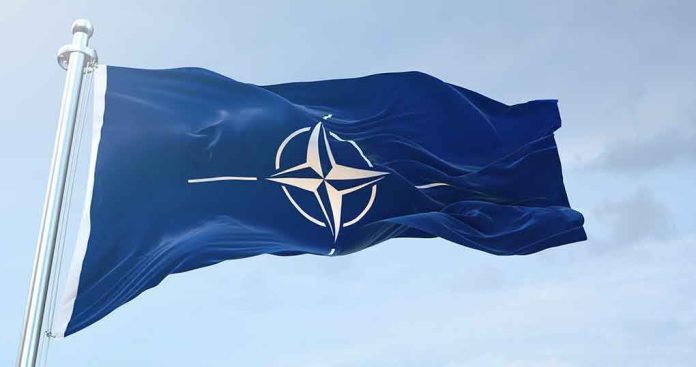
A new joint military drill on NATO’s doorstep brings nuclear-capable missiles to Belarus for the first time since the Cold War, raising alarms about escalating threats to Western security and the erosion of nuclear restraint.
Story Snapshot
- Belarus will practice deploying Russian nuclear-capable missiles in Zapad-2025 drills near NATO borders.
- This is the first explicit Belarusian participation in nuclear-capable exercises since the 1990s.
- The move follows Russia’s recent nuclear deployments and constitutional changes in Belarus.
- Experts warn of heightened risks, NATO tension, and the breakdown of post-Cold War nuclear safeguards.
Belarus and Russia Stage Nuclear-Capable Missile Drills Near NATO
Belarus announced it will take part in the deployment exercises of Russia’s nuclear-capable Oreshnik missiles during the Zapad-2025 (“West-2025”) military drills, set for September 12–16, 2025, close to the borders of Poland, Lithuania, Latvia, and Estonia. This marks a major escalation in the already tense military cooperation between Russia and Belarus, bringing explicit nuclear dimensions to a region that is already a flashpoint between NATO and Moscow. Western analysts view the move as a direct challenge to the security of NATO’s eastern flank, signaling a willingness by Moscow and Minsk to operationalize nuclear threats in their defense posture.
The Zapad exercises, held every two years, have long been considered by NATO to be rehearsals for potential conflict scenarios in Eastern Europe. However, the 2025 iteration stands out, as it is the first to feature Belarusian involvement in nuclear-capable missile training since the collapse of the Soviet Union. Preparations are underway, with both Russian and Belarusian forces coordinating logistics and strategy. Official statements from Belarus cite the “situation on our western and northern borders” as justification, underlining the regime’s alignment with Moscow’s broader military objectives and its reliance on Russian support for stability and security.
Belarus’s Nuclear Status Shifts After Decades of Restraint
Belarus, once a non-nuclear state after transferring all inherited Soviet warheads to Russia by 1996, has reversed its decades-long stance since 2022. Constitutional amendments that year cleared the way for Russian nuclear deployments on its territory, a process completed by late 2023. The operationalization of nuclear-capable assets on Belarusian soil in 2025’s drills cements this shift and erodes the non-proliferation norms that had defined the post-Cold War landscape in Eastern Europe. The move comes as Russia continues to use Belarus as a strategic buffer and forward operating base, with President Lukashenko’s government demonstrating little autonomy in defense policy and instead cementing its economic and political dependence on the Kremlin.
These developments have alarmed NATO and EU governments, who are now confronting the normalization of Russian nuclear deployments at their borders. Populations in neighboring countries face heightened security risks, and the increased militarization may trigger a new wave of defense spending and posturing across the region. The precedent set by these exercises could undermine arms control regimes and further destabilize a region already shaken by ongoing conflict in Ukraine and growing distrust between Moscow and the West.
Escalation Risks and the Breakdown of Nuclear Safeguards
Security analysts warn that bringing nuclear-capable missile drills to Belarus lowers the threshold for potential nuclear weapons use in Europe and increases the risk of miscalculation during periods of heightened tension. With no credible sources reporting the movement of actual nuclear warheads for the exercise, the focus remains on the deployment systems and their operational readiness. Nevertheless, the drills represent a clear message to NATO and the EU: Russia and Belarus are prepared to escalate, and the taboo against nuclear saber-rattling in Eastern Europe is fading.
The response from Western governments has been swift, with calls for increased vigilance and reassessment of regional defense strategies. Experts agree that these exercises, while framed by Russian and Belarusian authorities as defensive and routine, are interpreted by independent analysts and NATO officials as provocative and destabilizing. The risk of accidents, misinterpretations, and unintended conflict rises as both sides engage in military posturing and readiness drills along heavily militarized borders.
Expert Views and Broader Implications for Western Security
Academic and military experts highlight that Belarus’s transformation from a non-nuclear to a de facto nuclear-hosting state marks a significant break from post-Soviet disarmament trends. This shift challenges Western efforts to maintain nuclear restraint and stability in Europe. The drills also serve domestic propaganda purposes in both Russia and Belarus, reinforcing regime legitimacy by projecting strength against perceived Western encroachment. The defense and security sectors in Europe are likely to see increased demand for missile defense and intelligence capabilities as a result.
Belarus to practice nuclear-capable missile use in Russia drills #FMTNews #FMTWorld https://t.co/RlCySYwz2W
— Free Malaysia Today (@fmtoday) August 13, 2025
For American conservatives, these developments underscore the dangers of unchecked globalism, weak border policies, and the need for strong national defense. The erosion of nuclear safeguards near NATO’s eastern frontier is a stark reminder of the importance of upholding constitutional values, prioritizing secure borders, and resisting policies that embolden rival powers. As the West faces renewed threats from an emboldened Russia, vigilance and a clear-eyed commitment to national sovereignty and security remain more critical than ever.
Sources:
Belarus – Nuclear Threat Initiative
Zapad-2025 military drills include training in nuclear weapons use: Belarus – Anadolu Agency





